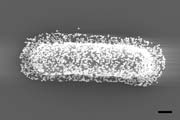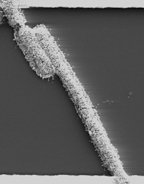Bionic Bacteria
Living, gold-coated bacteria can act as humidity sensors.
By Emily Sohn
Sometimes inanimate objects appear to act as if they’re alive. Doors suddenly slam shut on their own, lights flicker on and off, or refrigerators gurgle and gasp. It’s the spooky stuff of science fiction and horror movies.
Get used to the idea. Living gadgets may be on their way.
 |
|
A bacterium coated with tiny gold particles. |
| © Angewandte Chemie/Wiley |
Two chemical engineers from the University of Nebraska in Lincoln have turned simple bacteria into electrical devices that measure humidity. The craziest part of all is that the bacteria must be alive for the gadgets to work at first. After they get going, the sensors work even when the tiny microbes die.
To build the devices, the researchers started with a basic electrical device called a silicon chip. The chip contained gold electrodes, which are good at conducting electricity.
Next, the engineers grew a coating of a type of bacteria called Bacillus cereus. These microbes grouped together and formed bridges between the electrodes. Finally, the researchers dipped the chips into a solution that contained minuscule gold beads with a coating that made them stick to the bacteria.
 |
|
Coated with gold particles, these rodlike bacteria act as a living humidity sensor. The top and bottom bars are electrodes. |
| © Angewandte Chemie/Wiley |
To test their living sensors, the researchers passed electricity through the gold beads on the backs of the microbes that formed bridges. When humidity drops (which means that moisture levels in the air go down), the bacteria shrink. The distance between beads then decreases, so more electricity flows.
This humidity detector is extremely sensitive. Lowering humidity from 20 percent to zero causes 40 times as much electricity to flow across the bridge.
Now that researchers have figured out how to make a sensor out of living bacteria, they have set their sights on other devices. In the future, they hope to hitch microbes to electronic devices so that feeding these tiny captives results in a flow of electricity from the critters into the devices. Maybe microbe-powered batteries will someday run the really tiny iPods that your kids will use.—E. Sohn
Going Deeper:
Weiss, Peter. 2005. Bionic bacteria: Gold nanoparticles make gadgets of living microbes. Science News 168(Oct. 22):259-260. Available at http://www.sciencenews.org/articles/20051022/fob2.asp .







